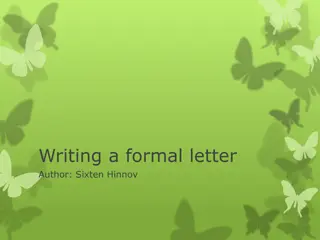Formal Analysis of Sculptures: Riace Warrior and Seated Buddha
Discover the formal analysis of the Riace Warrior and Seated Buddha sculptures, exploring their representations and significance. Analysis includes descriptions, visual evidence, and insights to deepen understanding.
Download Presentation

Please find below an Image/Link to download the presentation.
The content on the website is provided AS IS for your information and personal use only. It may not be sold, licensed, or shared on other websites without obtaining consent from the author.If you encounter any issues during the download, it is possible that the publisher has removed the file from their server.
You are allowed to download the files provided on this website for personal or commercial use, subject to the condition that they are used lawfully. All files are the property of their respective owners.
The content on the website is provided AS IS for your information and personal use only. It may not be sold, licensed, or shared on other websites without obtaining consent from the author.
E N D
Presentation Transcript
How to Write Formal Analysis Molly Duggins Academic English Coordinator Molly.duggins@nas.edu.au
Description and analysis Description is the first step of formal analysis (subject-form- historical context). After making a descriptive statement, you should explain how the effect is produced and why it is important to the experience or meaning of the artwork. Eg. Descriptive statement: The Riace Warrior is strong and commanding How is this achieved? Why is it important?
Descriptive statement: The Riace Warrior is strong and commanding How is this achieved? Why is it important? Riace Warrior A, c.450 BCE, bronze, 203 cm, Reggio di Calabria
The taut, rippling musculature and contrapposto of Riace A make him appear strong and commanding. As a result, he encapsulates the ar te of a warrior: dutiful, disciplined, and powerful. Riace Warrior A, c.450 BCE, bronze, 203 cm, Reggio di Calabria
How The taut, rippling musculature and contrapposto of Riace A make him appear strong and commanding. As a result, he encapsulates the ar te of a warrior: dutiful, Why disciplined, and powerful.
Applying analysis to answer a question How does this sculpture represent the Buddha and construct a relationship with the beholder? (250 words) Seated Buddha, Kushan period, 2nd century, red sandstone, 129.5 cm, National Gallery of Australia, Canberra
Break down question: 1. How does this sculpture represent the Buddha (paragraph 1) 2. How does it construct a relationship with the viewer (paragraph 2) What? + How? + Why? Observation + Visual Evidence + Insight
Make an outline for your response 1. How does this sculpture represent the Buddha? 2. How does it construct a relationship with the viewer
Make an outline for your response 1. How does this sculpture represent the Buddha? Pose and gesture Attributes of the Buddha Natural symbolism 2. How does it construct a relationship with the viewer Body as vessel for sacred breath Open eyes, gentle smile, palm inscribed with dharma Darshan as a form of spiritual exchange
Observation/visual evidence + insight Paragraph 1: How does this sculpture represent the Buddha? Pose and gesture Grounded in the seated lotus position of meditation with his right hand raised in the abhaya mudra gesture, this Mathuran Buddha greets the beholder with serenity and reassurance.
Observation/visual evidence + insight Paragraph 1: How does this sculpture represent the Buddha? Attributes of the Buddha Enveloped by a disc-like halo that proclaims his enlightened transcendence, the Buddha s ushnisha, or cranial protuberance, and urna the whorl of hair between his eyebrows make tangibly visible his superior wisdom and insight.
Paragraph 1: How does this sculpture represent the Buddha? Attributes of the Buddha, cont. While his elongated earlobes reference his bejewelled princely past, the Buddha s delicate features and supple form drawn from the natural world proclaim his transformation from mortal to deity. Broader interpretation drawn from specific insights: symbolism used to create iconic representation of Buddha as god
Paragraph 1: How does this sculpture represent the Buddha? Natural symbolism Inspired by ancient Indian texts, he embodies an ideal of masculine beauty characterised by vitality and virility, from his robust chest that resembles the face of a bull to his stylised, deeply cut eyes that evoke the darting curves of fish. Prioritise a few key examples rather than providing a laundry list of evidence
Paragraph 1: How does this sculpture represent the Buddha? right hand raised in the abhaya mudra gesture, this Mathuran Buddha greets the beholder with serenity and reassurance. Enveloped by a disc-like halo that proclaims his enlightened transcendence, the Buddha s ushnisha, or cranial protuberance, and urna the whorl of hair between his eyebrows make tangibly visible his superior wisdom and insight. While his elongated earlobes reference his bejewelled princely past, the Buddha s delicate features and supple form drawn from the natural world proclaim his transformation from mortal to deity. Inspired by ancient Indian texts, he embodies an ideal of masculine beauty characterised by vitality and virility, from his robust chest that resembles the face of a bull to his stylised, deeply cut eyes that evoke the darting curves of fish. (130 words) Grounded in the seated lotus position of meditation with his
Paragraph structure Paragraphs should begin with a topic sentence that clearly outlines your aims for the paragraph and define its content. All other material in the paragraph must relate to this stated aim in the topic sentence; this will help keep your ideas clear and focused. Develop strong transitions between your paragraphs.
Paragraph structure Consider using the P.E.E.L. formula to structure your paragraphs: Point Example Elaborate Link
Paragraph 2: How does it construct a relationship with the viewer? Body as vessel for sacred breath Such natural symbolism gives way to spiritual intent through a surface smoothness uninterrupted by ridges of muscle or bone. The Buddha s body is depicted as soft and pneumatic. His abdomen, distinguished by pillowy flesh that spills over his monastic robes, expands with sacred breath, or prana. Topic sentence links the two paragraphs
Paragraph 2: How does it construct a relationship with the viewer? Open eyes, gentle smile, palm inscribed with dharma Darshan as a form of spiritual exchange Through his steady gaze and gentle smile, indicative of his compassion and his absence of suffering, he offers his attention to the devotee who, in turn, seeks darshan an encounter with the divine energy animating the sandstone. Incised with the wheel of the dharma, the Buddha s extended palm signals the potential transmission of spiritual knowledge in return for the worshipper s reverence and respect. This reciprocal form of viewing initiates a spiritual exchange between the human and divine worlds.
Paragraph 2: How does it construct a relationship with the viewer? through a surface smoothness uninterrupted by ridges of muscle or bone. The Buddha s body is depicted as soft and pneumatic. His abdomen, distinguished by pillowy flesh that spills over his monastic robes, expands with sacred breath, or prana. Through his steady gaze and gentle smile, indicative of his compassion and his absence of suffering, he offers his attention to the devotee who, in turn, seeks darshan an encounter with the divine energy animating the sandstone. Incised with the wheel of the dharma, the Buddha s extended palm signals the potential transmission of spiritual knowledge in return for the worshipper s reverence. This reciprocal form of viewing initiates a spiritual exchange between the human and divine worlds. (122 words) Such natural symbolism gives way to spiritual intent
Tips for Writing the Object Analysis Use the questions as subheadings; there is no need to write an introduction or a conclusion for this assignment. Do not simply restate the question in the first line of your response. Avoid unnecessary repetition throughout your responses. Try to make new points in each response that specifically target the question. Avoid value judgements: Aesthetic judgements: This is a beautifully painted artwork that successfully conveys its meaning Moral judgements: This artwork is ethically problematic because of its representation of gender These tell us more about 21st-century attitudes than the artwork s own context
Tips for Writing the Object Analysis Use italics for artwork titles: Harriet Hosmer s sculpture, Beatrice Cenci, 1857, represents Beatrice lying asleep on a stone slab. Agnolo Bronzino s portrait of Cosimo I de Medici was painted around 1545 in the Mannerist style. In Djan kawu Creation Story, the artists represent the ancestors journey in episodic form. Only quote primary sources and keep quotations to a minimum. Use scholarly references in your footnotes and bibliography (books, and journal articles)























